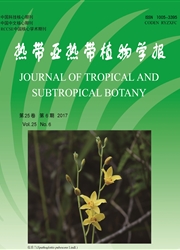

 中文摘要:
中文摘要:
为探讨舟山群岛次生林优势种群的关系,对桃花岛1hm2固定样地进行调查,分析了15个优势种群的生态位特征和种间联结性。结果表明,豹皮樟(Litseacoreanavar.sinensis)、红楠(Machilusthunbergii)和野梧桐(Mallotusjaponicus)具有较大的生态位宽度,其Levins生态位宽度分别为1.3563、1.3170、1.3097,Hurlbert生态位宽度分别为0.8572、0.7373、0.7154,而朴树(Celtissinensis)、柘(Macluratricuspidata)和梾木(Cornusmacrophylla)的生态位宽度较小。生态位相似比例大于0.5的种对有39对,占总对数的37.1%。生态位宽度大的种群之间相似比例较大,生态位宽度大的种群与生态位宽度小的种群也可能产生较大的重叠值,而生态位宽度小的种群一般不会与生态位宽度大的种群产生较大的重叠值。15个优势种群间总体呈现不显著负关联性,X2检验和联结系数结果均表明,负联结的种对较正联结的种对多。因此,舟山群岛次生林优势种群种间联结相对松散,具有一定独立性,但独立程度较低,群落尚不成熟,处于动态演替的不稳定阶段。阳性先锋树种天仙果处于衰退阶段,次生林将逐渐恢复成豹皮樟和红楠占优势的地带性常绿阔叶林。
 英文摘要:
英文摘要:
The aim was to understand the relationship among dominant species in secondary forest of Zhoushan islands. Based on investigation of 1 hm2 fixed plot in Taohua island, the niche characteristic and interspecific association of 15 dominant species were studied. The results showed that the niche breadth of Litsea coreana var.sinensis, Machilus thunbergii, Mallotus japonicus were broader than other species, with Levins and Hurlbert’ niche breadth values of 1.3563, 1.3170, 1.3097 and 0.8572, 0.7373, 0.7154, respectively, while Celtis sinensis,Maclura tricuspidata, Cornus macrophylla had narrow niche breadths. There were 39 species pairs with nichepro portional similarity more than 0.5, accounting for 37.1% of the total pairs. The broader niche of two specieshas, the bigger of their niche proportional similarity is. The species with broad niche could have big niche overlap with another species with narrow niche. On the contrary, the species with narrow niche could have low nicheoverlap with another species with broad niche. There were not significant negative associations overall among 15dominant species. The X2 test and association coefficient showed that species pairs with negative association were more than that with positive association. Therefore, the interspecific association of dominant species in secondary forest of Zhoushan islands was relatively loose with certain independent at low extent. The community was not mature and in the unstable stage of dynamic succession. The pioneer species Ficus erecta was in decline stage.The secondary forest will gradually recover to zonal evergreen broad-leaved forest, which is dominant by Litsea coreana var. sinensis and Machilus thunbergii.
 同期刊论文项目
同期刊论文项目
 同项目期刊论文
同项目期刊论文
 期刊信息
期刊信息
